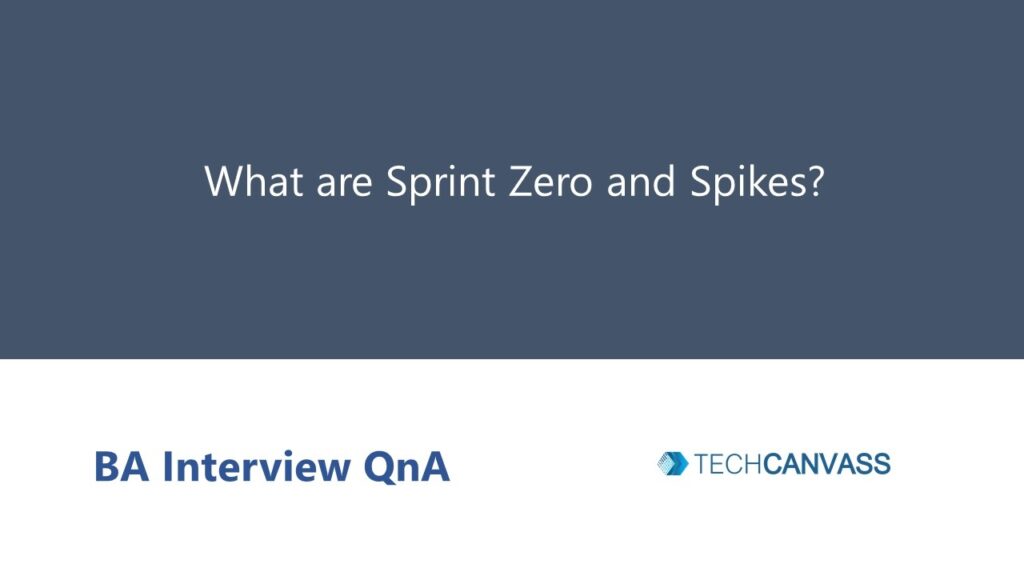Agile project management, which considers sprint zero and spike, breaks down the project management process into easily manageable portions known as Sprints to make it more manageable. As a result of its success, businesses are now beginning to apply Agile concepts to project management across departments. What is the difference between Sprint Zero and Spikes? In this post, we’ll talk about it. In today’s business world, these sprints have become very popular (read real-life scenarios) and it’s not surprising that you’ll be asked this question during an interview.
Your best career opportunity is just a few tests away. Start preparing for your Agile Analysis Certification exam now!
What Is Sprint Zero in Agile?
Sprint Zero is typically held before the official commencement and at the beginning of the team’s existence. The purpose of the Sprint is for the development team to come together and build a minimum amount of User Stories, a project skeleton, story mapping, and a usable product in a short period. This Sprint should be kept as light as possible while maintaining a high level of competition. What matters is the beginning of project exploration and understanding the direction you want to take while keeping velocity as low as possible.
What Are Spikes in Agile?
A spike is a user story for which the team must also estimate how much work will be required. As a result, conducting time-limited inquiry and exploration to learn more about the problem or alternative solutions is preferable. The team will break down the features into stories and estimate them as a result of the surge.
Purpose Of Sprint Zero and Spike in Agile
Agile spikes are intended to assist the Scrum Team in maintaining control over the delivery and remaining committed to the sprint goal. Spikes provide long-term trust, visibility, and predictability to the product roadmap, while The primary purpose of a Sprint Zero is to offer some meaningful value that can be improved upon by the following team. Sprint Zeros are responsible for the following tasks: Creating the project’s skeleton, which includes research spikes.
This is just an indicative list.
- Acquiring servers or hardware resources for the project
- Assembling the team
- Developing the initial backlog items (A few stories)
- Application Architecture design
Agile Events are what you want to work towards; updating the backlog, participating in daily stand-ups, doing a retrospective, and delivering an end-product, whatever that may be in this type of setup are all things you want to do.
When To Use Sprint Zero and Spikes in Agile?
Only when the product backlog has been refined can the spikes be identified. If, in addition to refining the user story or stories, there is still a great deal of ambiguity surrounding the estimations, then when it comes to using spikes following backlog refining.
There are four key scenarios in which Sprint Zero takes place:
- There are several possibilities; the development team will need to conduct additional testing to determine which one is the most appropriate.
- In this case, the development team is unsure whether the solution they are exploring will produce the desired results or not.
- The team is completely at a loss for how to address the problem.
- The team must complete some preliminary work before estimating the user story or series of user stories.
Goals, Activities & Benefits of Sprint Zero
Sprint Zero Goals
The primary goal of a Sprint Zero is the same as it is for a Scrum Sprint that is production. On the other hand, a Sprint Zero is not required to carry out as much heavy software development as a Scrum Sprint would. As previously stated, teams participating in Sprint Zero should keep it light.
More specifically, the following should be the deliverables of a Sprint Zero:
- A usable bit of code, no matter how little.
- A bare-bones environment for coding is provided.
- A priority of features or a list of tales are examples of prioritising.
- A release strategy that assigns each storey to a Sprint is shown below.
- A strategy for implementing features most reasonably.
Because the emphasis of a Sprint Zero is on ensuring preparation for a Sprint, some organizations or projects will not be required to use this methodology. With recent projects having produced successful Sprints, you may already be aware of your company’s Sprint preparedness condition without having to undertake a Sprint Zero.
You can read our post related to Product Owner vs Business Analyst vs Scrum Master
https://businessanalyst.techcanvass.com/product-owner-vs-business-analyst-vs-scrum-master/
Sprint Zero Activities
Sprint Zeros should follow the same procedures as regular Sprints, including the following:
- The backlog has been updated
- After that, there is a sprint planning session.
- Sprint team meetings are held on a daily basis.
- Review sessions or debriefing meetings after each sprint
- A product that will be delivered
- Retrospective on the sprint
Because we’ve already discussed the process that teams go through when they participate in a Sprint, the items on the above list may sound familiar. Sprint Zeros, on the other hand, Sprint Zeros should not last more than a few days or a week at the most, in contrast to other Sprints.
Sprint Zero Benefits
The primary advantage of a Sprint Zero is that it allows a team to sense the amount of work that lies ahead of them. This will enable them to organize themselves to perform better over the long term. This also helps instill confidence in team members that they will be able to tackle the task that lies ahead.
Individuals may get stalled during a project when they enter it without clarity. This could have an impact on the success of a Sprint. Sprint Zero aims to overcome this stumbling block by providing an opportunity to design a foundation for success and ensure a productive Sprint environment for the first sprint.
You may also like our latest blog related to “What Are Types of Product Owners“, click on the link, and explore other areas of Business Analyst.
https://businessanalyst.techcanvass.com/what-are-types-of-product-owners/
Goals, Activities & Benefits of Spikes in Agile
Spike Goals
A spike is an experiment that allows developers to evaluate the functional increment by exposing them to elements of the same story that they are unfamiliar with prior to releasing it. For a solution to be found, research must be conducted. The scrum team must immerse their brains and minds into the whole story of a circumstance, question, problem, issue, uncertainty, and risk to arrive at a solution. The scrum master cannot go into a solution to these issues without first identifying the problem. As a result, we employ spike scrums or spikes to solve the problem.
Spikes Benefits
A Spike is formed, and the team must conduct additional research or inquiry to complete the work. An estimate for the original user story is produced due to a spike, allowing the sprint to proceed as planned.
- Uncertainty is broken down.
- There is no pressure to do anything to ensure that the situation remains unclear indefinitely.
- Always have a clear understanding of where you are going.
- Avoid overestimating the importance of stories because of ambiguity.
Spike Activities
They must meet specific criteria, much like any other standard user story, in order to achieve the status of completed by ensuring that the “Spike Story” is estimable, verifiable, and acceptable:
Estimable
Spikes are added to the backlog in the same way as other stories; they are estimable and sized to fit within an iteration. A spike may result in a decision, a prototype, a storyboard, a proof of concept, or some other partial solution that will aid in the development of the ultimate product.
Demonstrable
The output of a spike can be demonstrated to the rest of the team. This increases the visibility of the research and architectural efforts while also fostering a sense of communal ownership and shared responsibility for the important decisions made in the process of discovery.
Acceptable
Spikes are accepted by the product owner in the same way that any other story is when the acceptance requirements for the spike are met.
Techcanvass’s PG Program in Agile Analysis Certification Course gives you broad exposure to key Agile Business Analyst concepts and tools.
Conclusion
Before the first sprint, Sprint Zero is introduced to conduct some research. Sprint zero is a sort of story for activities like research, exploration, design, and even prototyping. Typically, this sprint is used at the beginning of the project for activities like setting up the development environment, establishing the product backlog, etc. If you need to work on a technical or design issue between sprints, you can take spikes.
FAQs
A Sprint 0 is a short effort to develop a vision and a rough product backlog that allows for estimating a product release date. It involves:
1. Estimate roughly
2. Form backlog
3. Setup environment
4. Define user stories
Sprints typically last one, two, or four weeks. A team will typically have developed a working product increment in this project by the end of the sprint.
1. Make a sprint plan.
2. Backlog stories should be included in your sprint.
3. Begin sprinting.
4. Keep track of your team’s progress.
5. Finish the sprint.
Product backlog creation, infrastructure setup, architectural design, team resourcing, and test plan composition are all covered in Sprint 0. Prototype, design planning, and test validation are all part of prototyping.
Technical spikes are used to investigate various techniques in the solution domain. For example: Decide on whether to build or buy. Examine the impact of a new user story on performance or load.



